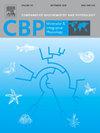罗氏沼虾IGFBP-rP cDNA的鉴定及其与生长性状的关系
IF 2.2
3区 生物学
Q4 BIOCHEMISTRY & MOLECULAR BIOLOGY
Comparative Biochemistry and Physiology A-Molecular & Integrative Physiology
Pub Date : 2025-06-27
DOI:10.1016/j.cbpa.2025.111901
引用次数: 0
摘要
胰岛素样生长因子结合蛋白(igfbp)是胰岛素样生长因子(IGFs)的关键调控因子,在生长发育过程中发挥重要作用。本研究从罗氏沼虾(Macrobrachium rosenbergii)中鉴定了一个IGFBP相关蛋白cDNA(标记为Mr-IGFBP-rP)。Mr-IGFBP-rP全长cDNA为1494个碱基对(bp),包括一个22 bp的5 ‘非翻译区(UTR)、一个707 bp的3 ’非翻译区(UTR)和一个765 bp的开放阅读框(ORF),编码254个氨基酸的蛋白。Mr-IGFBP-rP蛋白包含三个保守结构域:一个igf结合结构域(氨基酸34-89),一个kazal型丝氨酸蛋白酶抑制剂结构域(102-125)和一个免疫球蛋白样c2型结构域(147-245)。序列分析表明,Mr-IGFBP-rP与Palaemon carinicauda的IGFBP-rP1同源性为75.74%,与中国对虾(Penaeus chinensis)的同源性为63.26%。表达分析显示Mr-IGFBP-rP在腹部神经节中表达量最高,其次是鳃、心脏和脑。在Mr-IGFBP-rP中鉴定出11个单核苷酸多态性(snp)。其中,3个snp与罗氏沼虾的生长性状显著相关。具体来说,5263-G/A位点的AA基因型个体表现出更大的体重。5302-G/T位点TT基因型的小鼠体重、头胸高度和腹腔1段高度增加。相比之下,5743-G/C位点的CC基因型与头胸长度、头胸高度、腹段1高度和腹长缩短有关。本研究为了解Mr-IGFBP-rP在罗氏酵母生长调控中的作用奠定了基础。所鉴定的snp具有作为该物种标记辅助选择的候选标记的潜力。本文章由计算机程序翻译,如有差异,请以英文原文为准。

Characterization of the IGFBP-rP cDNA and its associations with growth traits in Macrobrachium rosenbergii
Insulin-like growth factor binding proteins (IGFBPs) are key regulators of insulin-like growth factors (IGFs), which play essential roles in growth and development. In this study, a IGFBP related protein cDNA from Macrobrachium rosenbergii (designated Mr-IGFBP-rP) was identified. The full-length cDNA of Mr-IGFBP-rP is 1494 base pairs (bp) including a 22 bp 5′-untranslated region (UTR), a 707 bp 3’-UTR, and a 765 bp open reading frame (ORF) encoding a 254-amino acid protein. The Mr-IGFBP-rP protein contains three conserved domains: an IGF-binding domain (amino acids 34–89), a Kazal-type serine protease inhibitor domain (102–125), and an immunoglobulin-like C2-type domain (147–245). Sequence analysis revealed that Mr-IGFBP-rP shares 75.74 % identity with the IGFBP-rP1 of Palaemon carinicauda and 63.26 % with that of Penaeus chinensis. Expression analysis showed that Mr-IGFBP-rP is most highly expressed in the abdominal ganglia, followed by gill, heart, and brain. Eleven single nucleotide polymorphisms (SNPs) were identified within Mr-IGFBP-rP. Of these, three SNPs showed significant associations with growth traits in M. rosenbergii. Specifically, individuals with the AA genotype at the 5263-G/A locus exhibited greater body weight. Those with the TT genotype at the 5302-G/T locus showed increased body weight, cephalothorax height, and abdominal segment 1 height. In contrast, the CC genotype at the 5743-G/C locus was associated with reduced cephalothorax length, cephalothorax height, abdominal segment 1 height, and abdominal length. This study lays a foundation for understanding the role of Mr-IGFBP-rP in growth regulation in M. rosenbergii. The identified SNPs hold potential as candidate markers for marker-assisted selection in this species.
求助全文
通过发布文献求助,成功后即可免费获取论文全文。
去求助
来源期刊
CiteScore
5.00
自引率
4.30%
发文量
155
审稿时长
3 months
期刊介绍:
Part A: Molecular & Integrative Physiology of Comparative Biochemistry and Physiology. This journal covers molecular, cellular, integrative, and ecological physiology. Topics include bioenergetics, circulation, development, excretion, ion regulation, endocrinology, neurobiology, nutrition, respiration, and thermal biology. Study on regulatory mechanisms at any level of organization such as signal transduction and cellular interaction and control of behavior are also published.

 求助内容:
求助内容: 应助结果提醒方式:
应助结果提醒方式:


